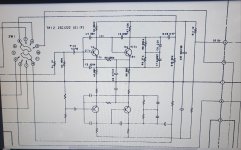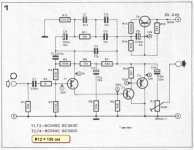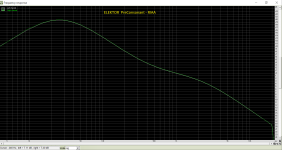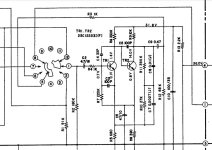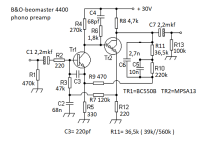So the good news. I got my Vintage Woodstock Amp up and running.
The bad news it Ceramic and Magnetic Head Phono Sections seem to be simple amplifiers.
There is no RIAA equalisation.
After spending a month studying the various possible solutions to this I have short listed two.
The requirements are simple. No op amp must be transistor based.
The Akai I have owned back in 79. I know it sounded and worked well. Even though its so basic.
The Self based design I have not experienced.
I guess the long and short of it is that I need to enter up both in a simulator and see how they perform. If you have any such modells pls share.
Reason for this post.
1. Just in case somebody is every looking for a very simple RIAA transistor circuit.
2. If any member has a collection of Transistor based RIAA schematics they can throw up. To compare to this.
3. Any obvious hack / mods improvements to this design.
(Im not interested in using op amp as thats a separate project. )
There is a 3rd option Im looking at but its way to complex I feel And that is the Phono Section from a NAD 2030 it matches the period.
MY only doubt is finding the right transistor to use on the akai schematic but last time I checked it was hard to find anything from that period. This amp Im making as a gift to my dad when its done.
The bad news it Ceramic and Magnetic Head Phono Sections seem to be simple amplifiers.
There is no RIAA equalisation.
After spending a month studying the various possible solutions to this I have short listed two.
The requirements are simple. No op amp must be transistor based.
The Akai I have owned back in 79. I know it sounded and worked well. Even though its so basic.
The Self based design I have not experienced.
I guess the long and short of it is that I need to enter up both in a simulator and see how they perform. If you have any such modells pls share.
Reason for this post.
1. Just in case somebody is every looking for a very simple RIAA transistor circuit.
2. If any member has a collection of Transistor based RIAA schematics they can throw up. To compare to this.
3. Any obvious hack / mods improvements to this design.
(Im not interested in using op amp as thats a separate project. )
There is a 3rd option Im looking at but its way to complex I feel And that is the Phono Section from a NAD 2030 it matches the period.
MY only doubt is finding the right transistor to use on the akai schematic but last time I checked it was hard to find anything from that period. This amp Im making as a gift to my dad when its done.
Attachments
Basically both the Akai and the Self-3 has the same topology, but the Self is smarter with the bootstrapping output buffer - it runs on a lower supply rail!
With such a vitage amp it might not a surprise no RIAA eq-circuit was incorporated. Ceramic has a 'natural' correction (most people won't notice) and high output. I guess the magnetic head input is intended for tapes (NAB correction), not cartridges.
With such a vitage amp it might not a surprise no RIAA eq-circuit was incorporated. Ceramic has a 'natural' correction (most people won't notice) and high output. I guess the magnetic head input is intended for tapes (NAB correction), not cartridges.
my favorite topologies are this:
1) with passive RIAA network between two gain stages:
https://www.diyaudio.com/community/threads/simplistic-njfet-riaa.129126/
https://www.diyaudio.com/community/threads/pacific-riaa-phono-pre-failure.227348/
https://www.diyaudio.com/community/threads/pass-pearl-2.381914/
https://www.diyaudio.com/community/threads/jfet-srpp-riaa-preamp.64028/
2) with RIAA network in the NFB loop (active equalizing)
https://www.diyaudio.com/community/...-for-creeks-phono-stage-obh-9-mc-only.396341/
https://www.diyaudio.com/community/threads/how-convert-creek-obh-8-to-mc-cartridges.151527/
3) inverted mode MM phono stage
https://www.diyaudio.com/community/threads/jlh-liniac-riaa.267770/
https://www.diyaudio.com/community/...king-in-inverted-mode-not-to-find-why.222677/
https://www.diyaudio.com/community/threads/riaa-amp-using-shunt-feedback.249557/
check out also this URLs:
https://www.diyaudio.com/community/threads/fet-vs-bjt-input-phono-preamp.357649/
1) with passive RIAA network between two gain stages:
https://www.diyaudio.com/community/threads/simplistic-njfet-riaa.129126/
https://www.diyaudio.com/community/threads/pacific-riaa-phono-pre-failure.227348/
https://www.diyaudio.com/community/threads/pass-pearl-2.381914/
https://www.diyaudio.com/community/threads/jfet-srpp-riaa-preamp.64028/
2) with RIAA network in the NFB loop (active equalizing)
https://www.diyaudio.com/community/...-for-creeks-phono-stage-obh-9-mc-only.396341/
https://www.diyaudio.com/community/threads/how-convert-creek-obh-8-to-mc-cartridges.151527/
3) inverted mode MM phono stage
https://www.diyaudio.com/community/threads/jlh-liniac-riaa.267770/
https://www.diyaudio.com/community/...king-in-inverted-mode-not-to-find-why.222677/
https://www.diyaudio.com/community/threads/riaa-amp-using-shunt-feedback.249557/
check out also this URLs:
https://www.diyaudio.com/community/threads/fet-vs-bjt-input-phono-preamp.357649/
Hello ! One of the simple phonopreamps is Elektor PreConsonant ( its scheme was published in Elektor 1978/07-08 ) . It has a good sound , affordable components . I built 2 such phono preamps - on silicon and germanium transistors . Both versions sound good . Here is the original circuit - it has a gain of about 32 db / 1 khz. To increase the gain , you need to change the nominal value of R12 .
Attachments
Thanks for that advice.
Under
https://www.lencoheaven.net/forum/index.php?topic=38309.0
you will find the associated elektor article in english
if one scroll down there are additional very interesting elektor RIAA phono preamp articles
Under
https://www.lencoheaven.net/forum/index.php?topic=38309.0
you will find the associated elektor article in english
if one scroll down there are additional very interesting elektor RIAA phono preamp articles
Here are the graphs of frequency measurements of Elektor PreConsonant . This is the frequency response measured using ASUS Xonar and RMAA . The second graph shows the measurement using the inverse-RIAA circuit.
Attachments
What am amazing resource this forum and its members are. Thank you so much for all the help.
For now I'm going to go with the 2 transistor Akai schematic because its the easiest to throw together on a bare PCB.
will also try and get each of the other designs entered up in LTSpice or Proteus. This should help with tuning the values.
I have decided to bite the bullet and get started with the process of learning how to use LT Spice. Even though Im more comfortable using Proteus.
The first issue I have run into is that when ever I try to open any spice file it throws up an error saying I cant find this Transistor. So I traced it to the file standard.bjt likewise there are a lot of other standard. files.
I am going to do a search online and look for these files. But something tells me this is a file people build up on their own with use.
Would some of the old foxes of LT spice consider sharing their files
Lot of time and effort in getting to grips with a new software. But it would seem its a must have skill for this journey into the world of audio.
Did this find this link here with a quick search. Anything better out there.
https://ltwiki.org/index.php?title=Standard.bjt
For now I'm going to go with the 2 transistor Akai schematic because its the easiest to throw together on a bare PCB.
will also try and get each of the other designs entered up in LTSpice or Proteus. This should help with tuning the values.
I have decided to bite the bullet and get started with the process of learning how to use LT Spice. Even though Im more comfortable using Proteus.
The first issue I have run into is that when ever I try to open any spice file it throws up an error saying I cant find this Transistor. So I traced it to the file standard.bjt likewise there are a lot of other standard. files.
I am going to do a search online and look for these files. But something tells me this is a file people build up on their own with use.
Would some of the old foxes of LT spice consider sharing their files
Lot of time and effort in getting to grips with a new software. But it would seem its a must have skill for this journey into the world of audio.
Did this find this link here with a quick search. Anything better out there.
https://ltwiki.org/index.php?title=Standard.bjt
So far I have multiple spice models for this PreConsonant its confusing as to which one to use.Here are the graphs of frequency measurements of Elektor PreConsonant . This is the frequency response measured using ASUS Xonar and RMAA . The second graph shows the measurement using the inverse-RIAA circuit.
You seem to have built it and tested it. Would it be possible for you to share your spice model file ?.
Have downloaded and started to learn LT spcie.
My plan is to build the simple 2 transistor circuit in spice and then to try and build the PrConsonant model.
Wont lie when I say its all a bit overwhelming when your trying to teach an old dog new tricks / stuff. lol.
Proteus was so much simpler and easier to use. But I no longer have access to it.
Hello! I have not modeled this PreConsonant scheme . First I saw a video on YouTube where the work of this phono preamp was shown . Then I found an Elektor publication with a description of this scheme . And I built such a preamp for myself . Then I took measurements . The graphs were obtained by measuring a real phono preamp ( my copy ) . I used transistors BC-549/559 ( Motorola ) - from my old stocks ....This is a good scheme. It is better than 2-transistor circuits.So far I have multiple spice models for this PreConsonant its confusing as to which one to use.
You seem to have built it and tested it. Would it be possible for you to share your spice model file ?.
Have downloaded and started to learn LT spcie.
My plan is to build the simple 2 transistor circuit in spice and then to try and build the PrConsonant model.
Wont lie when I say its all a bit overwhelming when your trying to teach an old dog new tricks / stuff. lol.
Proteus was so much simpler and easier to use. But I no longer have access to it.
A few years ago , the PreConsonant scheme was already discussed on this forum . And a simulation of this scheme was published ( from Salas ) . It was in this thread - https://www.diyaudio.com/community/threads/discrete-phono-stage-single-supply.255309/page-3
So the amp we owned in 79 was a 2400 I have started to go thru all Akia amps that followed so as to study how this 2 transistor circuit evolved over the years. So far I have reached 2800 the image is more clear. And still on 2 transistors. I know the AMU 310 I just repaired from the 80s uses a Op Amp. For phono which works and sounds good.
But I still need to make a Phono Section for my WoodStock Amp I am giving dad.
Thanks for getting back to me and the link I follow up on that path.
But I still need to make a Phono Section for my WoodStock Amp I am giving dad.
Thanks for getting back to me and the link I follow up on that path.
Attachments
I have used 2-transistor phonopreamps. Usually they allowed you to get a pretty comfortable sound .
BUT - many 2-transistor circuits have insufficient gain at low frequencies ( 20-40 Hertz) . This is a feature of such circuitry . This is clearly seen when measuring the frequency characteristics of such preamps .
And many of these circuits had a fairly high output impedance . They were designed to be connected to a high - impedance amplifier input ( more than 100 kohm ) .
More complex circuits - have less deviation from the RIAA standard , and give a deeper bass .
In principle, assembling a 4-transistor circuit is not much more difficult than assembling on 2 transistors.
BUT - many 2-transistor circuits have insufficient gain at low frequencies ( 20-40 Hertz) . This is a feature of such circuitry . This is clearly seen when measuring the frequency characteristics of such preamps .
And many of these circuits had a fairly high output impedance . They were designed to be connected to a high - impedance amplifier input ( more than 100 kohm ) .
More complex circuits - have less deviation from the RIAA standard , and give a deeper bass .
In principle, assembling a 4-transistor circuit is not much more difficult than assembling on 2 transistors.
Wow, what an effort! I guess the first, discrete part could be substituted by a JFET input opamp, couldn't it? Anyway, what defines the resistive part of the cartridge load?
Best regards!
Best regards!
Wouldn't a simple resistor of 1500*120/3420 = 52.6 k (or even better 47 k) also do? Why that opamp?
Best regards!
Best regards!
Ask the designer, he is the member here. Its called actidamp for active damping i suppose. I just build it.
I found one more 2 transistor design that can be give you 5 different RIAA standards.
Its on page 27 of the Philips Application book on Audio Amplifiers. You can find PDFs online.

Its on page 27 of the Philips Application book on Audio Amplifiers. You can find PDFs online.
What I am looking for the simplest smallest design. That does what its supposed to. Not chasing perfection.
The AM-2400 blew my mind as a kid. And if I can just get as close as that to possible Id be happy.
I have another project where the same is being done by op amps. That one can get as complex as it needs to be.
Here I want to get it done with 2 or 3 transistors. Ok 4 if its really needed.
The AM-2400 blew my mind as a kid. And if I can just get as close as that to possible Id be happy.
I have another project where the same is being done by op amps. That one can get as complex as it needs to be.
Here I want to get it done with 2 or 3 transistors. Ok 4 if its really needed.
- Home
- Source & Line
- Analog Line Level
- Simple Transistor based RIAA
